by Ariane Koek
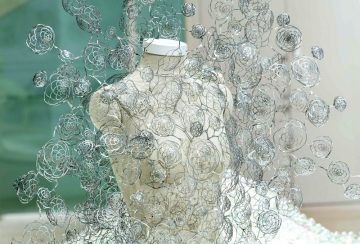
The architect Sou Fujimoto thinks of space as ‘densities’ and says architecture ‘is like handling the densities of the air’
“An endless sea of possibilities…of particles jumping in and out of existence” – that’s the description of space by the physicist Bilge Demirköz, who helped build the Alpha Magnetic Spectrometer (AMS) detector on the International Space Station, thinks of space.
“Matter is creation, its evolution, it’s nature, it’s us” – that’s how Fashion designer Iris van Herpen describes matter. The physicist Michael Doser describes matter, the subject of his life’s work, as ‘massive, compace, heaty, light, transparent, filmy, an illusion.”
Different ways of looking at the same phenomena, revealing different ways of knowing and experiencing it through the mind or body or both. Laid out side by side in my book Entangle: Physics and the Artistic Imagination, seven physicists and seven artists individually explore what seven different phenomena mean to them. Their interviews reveal the differences as well as connections of seeing the same phenomena through different eyes. It is my belief that it is in the connections, the differences, and the gaps in between, that the two most unique aspects of being human thrive and grow – the sacred space of the imagination and creativity.
Thanks to these connections, differences and gaps we are forced to think and imagine beyond our own parameters, particularly by not knowing and by our failure to fully understand. After all, we only learn to walk as a child by falling down and picking ourselves up, time and time again, until we know our own limits and once we have tested gravity, like amateur physicists, to our utmost capability. Knowledge is built on the unknown and failure, with imagination daring to take us beyond our habitual physical and conceptual limits, as the first Arts at CERN Collide artist in residence, German artist Julius von Bismarck shows in his video piece Escape Shapes (2016) which is composed of a multiplicity of different clips of failed rocket launches.
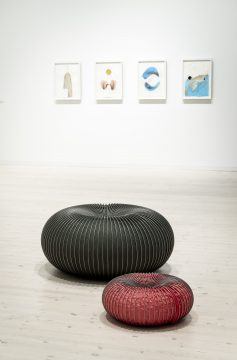
In background Jorinde Voigt – Space Study 1-4 (2016) Photograph: Mikael Lundgren/Bildmuseet
Julius himself says: “What makes it [physics] so inspiring for me is that you can always discover something that you couldn’t understand or even imagine before and that you maybe still can’t imagine. This boundary of my imagination is where I get a lot of inspiration. Every new weird fact that is funny to imagine or hard to imagine is for me an inspiration to go into a corner of my brain that I haven’t used before or that is not existing yet. I have to kind of extend my imagination to understand it. Then, I’m failing in that. I like that failure. That’s actually an inspiration for a couple of works I made.”
Or as the physicist Albert Einstein famously said in a renowned newspaper interview published in The Saturday Evening Post in 1929: “Knowledge is limited. Imagination embraces the whole world.”1
It is this space of the imagination which different ways of knowing create when they encounter each other, which inspired me to initiate, create and direct for five years the Arts at CERN programme at the world’s largest particle physics laboratory outside Geneva. From the moment I began building Arts at CERN in 2010 – now 10 years ago – I talked about the beauty of what I called ‘creative collisions’ – and how they open up a space for both artists and the scientists alike to smash through paradigms and fixed ways of thinking. The programme concentrated in its first five years when I was directing it, on the magic of the process of imagination, different ways of knowing and looking at the world colliding with each other, with no expected outcomes.
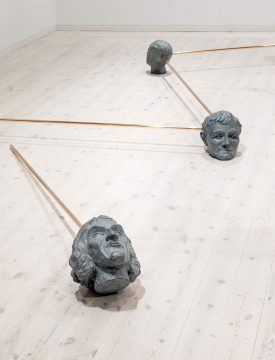
But the imagination is not just the exclusive domain of artists: it is fundamental to both experimental and theoretical physicists and the actual process of discovery as the science writer Philip Ball lays out in his important and ground-breaking essay in my book. The role of the imagination in discovery was also considered when the best-selling physicist Carlo Rovelli, was drawing on one of the blackboards that form part of the Polish artist Goshka Macuga’s new commission for the exhibition I curated on physics and art at Bildmuseet, Sweden. It is a composite installation comprising black- boards drawn on by nine contemporary physicists, the German artist Joseph Beuys, Albert Einstein, and the founder of biodynamics and educationalist Rudolf Steiner. When Rovelli wrote an equation using the Penrose system for describing his theory of the white hole, the theoretical opposite counterpart to the black hole, he said that just because white holes in the universe haven’t been seen yet doesn’t mean that they don’t exist. “You just have to imagine them.” He added that when black holes were first predicted by Einstein in 1916 with his general theory of relativity, people said they did not exist. Fifty-five years later, the first one was observed and now they are commonly accepted as real.
Thus, the notion of science as being purely objective and logical is a myth. Imagination and intuition are entangled in the process of scientific discovery, just as they are in the artistic process. Our perception of science as the ultimate objective truth, which precludes the imagination, dates from the Enlightenment — the so-called Age of Reason, in the seventeenth century. This false separation may be due to a fear of science’s origins when it was closely associated with alchemy — which is often characterized as the search for the philosopher’s stone — the key to the material world and the transformation of matter, including base metals to gold. Science, in particular chemistry and the natural sciences, became detached from the perceived magic of alchemy by creating scientific methodology, factual proof, and analysis. But the imagination is very closely connected to magic. As Philip Ball also points out in his essay in my book, imagination shares the same etymological root as “magic” — “which, in the age just before the time of Isaac Newton, did not necessarily mean superstitious agency but the ‘hidden forces’ by which natural magicians comprehended and claimed to manipulate nature.”
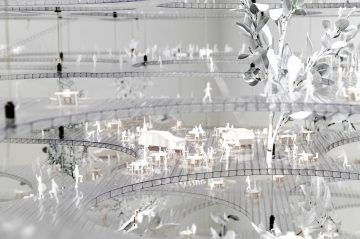
Photograph: Mikael Lundgren/Bildmuseet
However, there may be a more complex reason for the separation of the imagination from science. It may relate to power and social control. The Italian philosopher Federico Campagna in his book Technic and Magic: The Reconstruction of Reality starts on the premise that reality is always a reconstruction.2 Reality is never real per se. In fact, this is certainly what science says. We don’t ever actually see an object in the real world: we only see the light bouncing off it, which is reflected in our eyes, and then our brains create an impression of the object which we then “see.” He charts from the Age of Enlightenment the rise of Techne — logic, form, and order with its language of absolutism — as a way of controlling human beings and thus their behavior. Magic or the imagination poses a threat to Techne’s social and political control of the masses because it centers its reconstruction of the world around the notion of the “ineffable,” the unnamable and inexplicable which cannot be put into words or ever be pinned down, yet lies at the very heart of existence. This idea is not far away from the writings of the Romantic poets, such as Percy Bysshe Shelley, who wrote about the radical ability of the imagination to challenge all borders and to create revolution. He also went so far as to claim that the imagination is the “great instrument of the moral good.”
I would go so far as to also say that this is why today contemporary art is becoming persistently driven to become utilitarian and more useful. Art is increasingly in danger of becoming a direct tool to describe, illustrate, and/or co-create solutions for political and social issues — what I would call “art by design.” There is increasing pressure for contemporary art to have a purpose, system, and logic, which bleeds it of its mystery and ineffability — and thus also dissolves its imaginative and experiential powers as well as aesthetics. These powers also can transform lives, change attitudes, ways of looking at and experiencing the world — but they are not directly applied or measurable. Couple this with the rise of science and technology as dominant cultural and economic forces, and there is also the danger that science and technology together may swallow contemporary art whole — and become the more dominant part — to the detriment of art and ultimately of society.
All of these different factors create an urgent need to investigate and revise the way in which we understand the relationship between science and the arts, their histories, and how they intra-relate. One important step in this direction is a new book called The Experimental Imagination by the academic Tita Chico.3 She shows that the arts and sciences in fact borrowed from each other in order to argue their legitimacy as modes of knowledge-making in Britain during the eighteenth-century Enlightenment. Literature used the tropes of science to legitimize its own claims to objectivity, whilst science used metaphors from literature as a way of explaining the imagination of science, giving it status by laying claim to be communicating to the popular realm. As her work shows, it is too simplistic to suggest that the Enlightenment heralded the division between objectivity and rationalism in science, and ego and experience in the humanities. The intra-connectiveness is far more complex than that. And we are only just beginning to unravel this entanglement.
Furthermore, Linda Dalrymple Henderson, the primary academic in the field of physics and art, based at the University of Texas at Austin, sheds new light on the relationship with the arts from the scientific point of view. She points out that ideas about space and time in fiction predated those of Einstein, which led to the general theory of relativity. Works of fiction may have opened up scientists’ minds to exploring these possibilities in the first place.4 This hints at what the eminent biologist Edward O. Wilson calls the extra dimension of the humanities, which science doesn’t have: “the infinity of fantasy worlds.”5
What is increasingly emerging in the fashion for art science or sci art is growing anecdotal evidence of how in fact the arts are influencing the work of the scientists themselves. For example, the theoretical physicist James Wells, who amongst other areas, looks at extra dimensions and new worlds, participated in the Arts at CERN program. He talked about how the experience of working with Julius von Bismarck made him look at his own theoretical work differently and would no doubt affect his findings in the future. The experimentalist and antimatter expert Michael Doser, one of the founding members of the CERN Cultural Board for the Arts program, similarly talked about how working with artists taught him how the artists’ enjoyment of detours in making work caused him to look at alternative ways of problem solving his scientific experiments.6 However, there is no proof that these interactions have led to big discoveries — yet. Much more academic investigation and extensive long-term tracking are required into how the arts have impacted upon science, and scholarship is only at the beginning. But what can be said without doubt, according to the former physicist and Director of FACT, Liverpool, UK, Nicola Triscott, is that the culture of physics as a whole is benefiting through what the philosopher John Dewey calls the “experiential” possibilities of art and its humanizing effect.
All of these factors point to the histories of arts and science being much more entangled than has been appreciated. There may very well be an “intra-action” between the arts and science — very much as there is in “tangential realism” — the approach created by the physicist turned philosopher Karen Barad. In her influential book Meeting the Universe Halfway from 2007, she talks about how everything is entangled — subject and object, inanimate and animate, sentient and non-sentient beings, stressing that
To be entangled is not simply to be intertwined with another, as in the joining of separate entities, but to lack an independent, self-contained existence. Existence is not an individual affair.7
This is what Barad calls “intra- action,” where the existence of one thing affects the existence and composition of another entity, whether sentient or not, across time and space. It’s always changing, and always in the process of being. This is the entanglement described in the introductory essay by Carlo Rovelli, which also contains an honest and forthright con- fession: that we don’t know how entanglement works the way it does. We just know what it does. As physics itself admits, we only know 6 percent of the universe. We have another 94 percent learn more about, which apparently comprises the mysterious Dark Matter and Dark Energy which theoretically make up the rest of the universe.
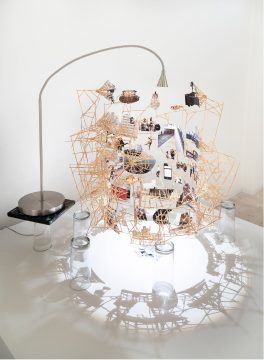
For the next steps in scientific discovery, just as in art, what we need more of is greater curiosity, and above all our imagination and creativity, to drive knowledge and our different ways of knowing forward.8 And perhaps that indicates what is really at the heart of all our existences: not only the intra-action between the visible and invisible, the material and immaterial, but also, crucially, “the ineffable.” This cannot be contained/explained/reduced to a formula however hard we try in our rational and technological age. Like the American artist, Sarah Sze’s piece Dark Matter, which was in the exhibition at Bildmuseet and is seemingly made up of random detritus — photographs, postcards, glass tumblers, a reading lamp — what is entangled is that indefinable and illusive space on the borders of consciousness and unconsciousness, where imagination and knowledge meet. In that space, as in Sarah’s work, we are in a constant state of entangled be-(com)ing — together (a)part.
***
This is an adapted edition of my introductory essay in Entangle: Physics and the Artistic Imagination (Hatje Cantz/Bildmuseet 2019) Editor Ariane Koek. With essays by Carlo Rovelli, Philip Ball, Nicola Triscott, Ariane Koek and Gavin Parkinson. Featuring the work of 14 contemporary artists who are inspired by physics in different ways including the fashion designer Iris van Herpen, the architect Sou Fujimoto and artists William Kentridge, Jorinde Voigt and musician Ryoji Ikeda. https://www.hatjecantz.de/entangle-7394-1.html
Link to the exhibition curated by Ariane Koek Entangle: Physics and the Artistic Imagination at Bildmuseet, Umea, Sweden (October 2018-April 2019): http://www.bildmuseet.umu.se/en/exhibition/entangle/31713
Link to a short film showing the exhibition Entangle: Physics and the Artistic Imagination at Bildmuseet, Umea, Sweden (October 2018-April 2019): https://www.youtube.com/watch?v=lDygWkzOXgw
FOOTNOTES
1 “What Life Means to Einstein: An Interview by George Sylvester Viereck,” The Saturday Evening Post, October 26, 1929, http://www.saturdayeveningpost.com/wp-content/uploads/ satevepost/what_life_means_to_einstein.pdf.
2 Federico Campagna, Technic and Magic: The Reconstruction of Reality (London: Bloomsbury, 2018).
3 Tita Chico, The Experimental Imagination: Literary Knowledge and Science in the British Enlightenment (Stanford, CA: Stanford University Press, 2018).
4 Peter L. Galison, Gerald Holton, and Silvan S. Schweber, eds., Einstein for the 21st Century: His Legacy in Science, Art, and Modern Culture (Princeton, NJ: Princeton University Press, 2008), p. xiii.
5 Edward O. Wilson, The Origins of Creativity (London: Penguin, 2018), p. 187. “If science is the bedrock of the humanities, the humanities have further reach. Where scientific observation addresses all phenomena existing in the real world, scientific experimentation addresses all possible real worlds, and scientific theory addresses all conceivable worlds, the humanities encompass all three of these levels and one more, the infinity of all fantasy worlds.”
6 Quotes taken from notes on conversations with the author in 2012–14.
7 Karen Barad, in her influential book Meeting the Universe Halfway: Quantum Physics and the Entanglement of Matter and Meaning from 2007, published by Duke University Press.
8 In 2011, the National Science Foundation in the USA, in collaboration with The Exploratorium, San Francisco, held a conference called Art as a Way of Knowing. This landmark con- ference with over 125 international artists, scientists, and transdisciplinary thinkers posited that the arts are a legitimate way of inquiry, research, and knowing as much as the sciences. See Marina McDougall, Bronwyn Bevan, and Robert Semper, “Art as a Way of Knowing Conference Report,” 2012, https://www.exploratorium.edu/files/pdf/cils/Art_as_a_Way_of_Know- ing_report.pdf.
Short Biography
Ariane Koek is an independent arts/science consultant, artistic director, producer and writer. She is also a specialist in artists residency programmes. She initiated and founded Arts at CERN in 2010, designing and directing the 3 strands – Collide international and swiss residencies, Accelerate and Visiting Artists programmes until 2015. Today she is a “recognized world leader in the field of science and art”(Andrea Bandelli, Director of Science Gallery International.
She is Senior Arts Advisor to the Exploratorium, San Francisco, USA, Founder and Producer of Earth Water Sky environmental arts and science residencies at Science Gallery Venice, Italy, and Creative Partner on the new Cavendish Arts Science programme, University of Cambridge, UK.
In 2020 she is co-curator of Real Feelings: Emotion and Technology at HEK, Basel, Switzerland which opens Mays 27th, and Backlight – the Nordic Photography Triennale held in Tampere, Finland September 2020. Her book Entangle: Physics and the Artistic Imagination featuring essays by Philip Ball, Gavin Parkinson, Carlo Rovelli and Nicola Triscott was published by Hatje Cantz/Bildmuseet Autumn 2019
Website: https://www.arianekoek.com Twitter: Beauty Quark
Linked In : https://www.linkedin.com/in/ariane-koek-243241b/
